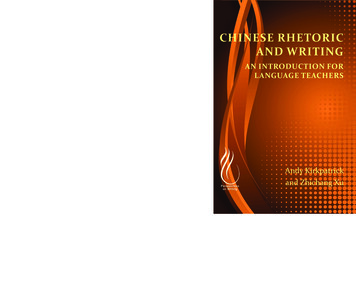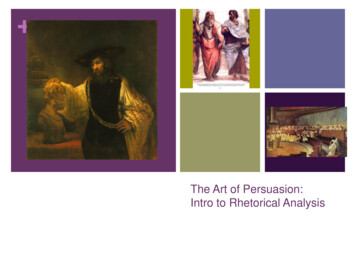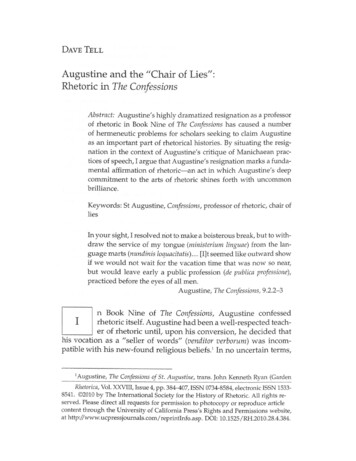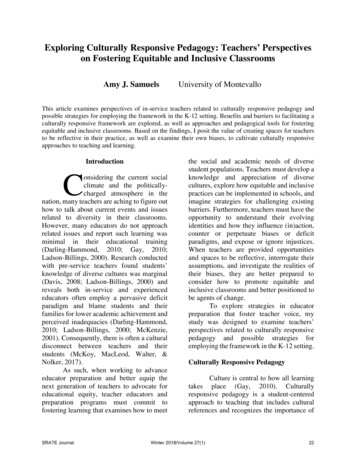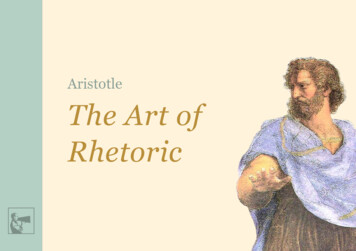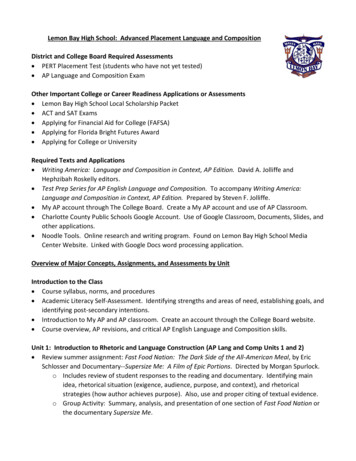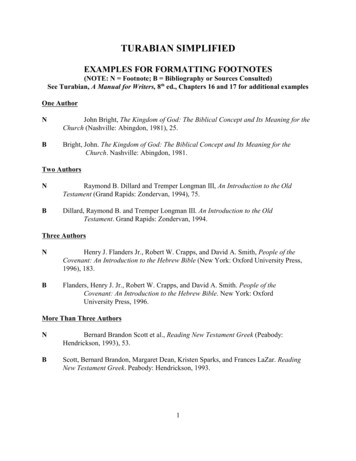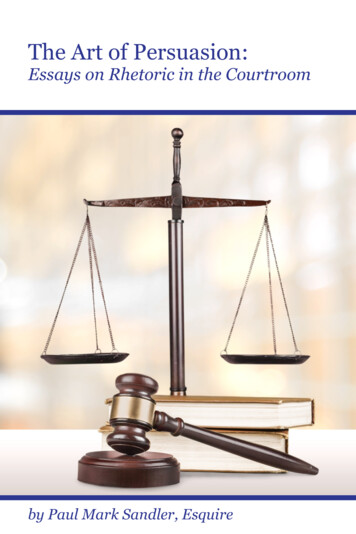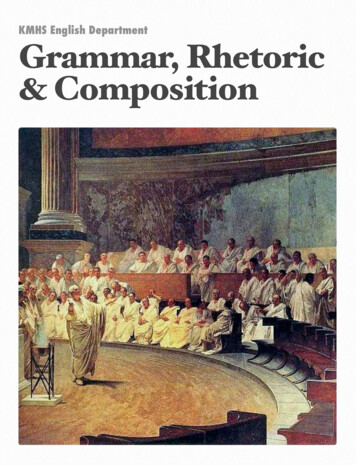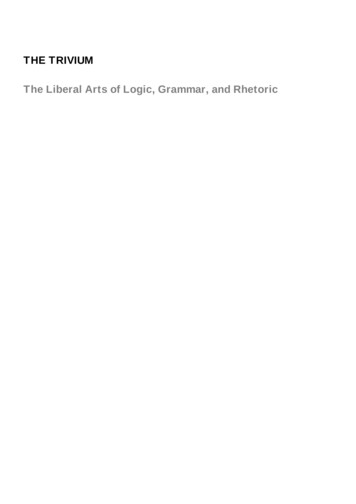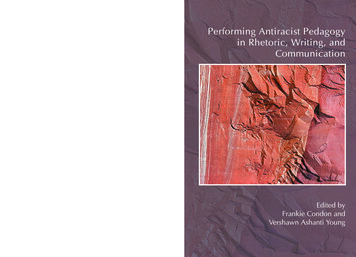
Transcription
Performing Antiracist Pedagogyin Rhetoric, Writing, andCommunicationEdited byFrankie Condon andVershawn Ashanti Young
Performing Antiracist Pedagogyin Rhetoric, Writing, and Communication
Across the Disciplines BooksSeries Editor, Michael A. PembertonThe Across the Disciplines Books series is closely tied to published themed issuesof the online, open-access, peer-reviewed journal Across the Disciplines. In keepingwith the editorial mission of Across the Disciplines, books in the series are devoted tolanguage, learning, academic writing, and writing pedagogy in all their intellectual,political, social, and technological complexity.The WAC Clearinghouse, Colorado State University Open Press, and UniversityPress of Colorado are collaborating so that these books will be widely availablethrough free digital distribution and low-cost print editions. The publishers and theseries editors are committed to the principle that knowledge should freely circulate.We see the opportunities that new technologies have for further democratizingknowledge. And we see that to share the power of writing is to share the meansfor all to articulate their needs, interest, and learning into the great experiment ofliteracy.
Performing Antiracist Pedagogyin Rhetoric, Writing, and CommunicationEdited by Frankie Condon and Vershawn Ashanti YoungThe WAC Clearinghousewac.colostate.eduFort Collins, ColoradoUniversity Press of Coloradoupcolorado.comLouisville, Colorado
The WAC Clearinghouse, Fort Collins, Colorado 80523University Press of Colorado, Boulder, Colorado 80303 2017 by Frankie Condon and Vershawn Ashanti Young. This work is licensed under aCreative Commons Attribution-NonCommercial-NoDerivatives 4.0 International License.ISBN 978-1-64215-093-3 (PDF) 978-1-64215-094-0 (ePub) 978-1-60732-649-6 (pbk.)DOI 10.37514/ATD-B.2016.0933Printed in the United States of AmericaLibrary of Congress Cataloging-in-Publication DataNames: Condon, Frankie, editor. Young, Vershawn Ashanti, editor.Title: Performing antiracist pedagogy in rhetoric, writing, and communication / edited byFrankie Condon and Vershawn Ashanti Young.Description: Fort Collins, Colorado : The WAC Clearinghouse ; Boulder, Colorado :University Press of Colorado, [2016] Series: Across the disciplines books Includesbibliographical references.Identifiers: LCCN 2016045186 ISBN 9781642150933 (pdf ) ISBN 9781642150940(epub) ISBN 9781607326496 (pbk.)Subjects: LCSH: English language—Rhetoric—Study and teaching (Higher)—Socialaspects—United States. Report writing—Study and teaching (Higher)—Social aspects—United States. Mass media—Study and teaching (Higher)—Social aspects—United States. Anti-racism—Study and teaching (Higher)—United States.Classification: LCC PE1405.U6 P385 2016 DDC 808/.042089—dc23LC record available at https://lccn.loc.gov/2016045186Copyeditor: Brandy BippesSeries Design: Tara ReeserBook Design: Tara ReeserCover Art and Design: Malcolm ChildersSeries Editor: Michael A. PembertonThe WAC Clearinghouse supports teachers of writing across the disciplines. Hosted byColorado State University, and supported by the Colorado State Univeristy Open Press, itbrings together scholarly journals and book series as well as resources for teachers who usewriting in their courses. This book is available in digital formats for free download at wac.colostate.edu.Founded in 1965, the University Press of Colorado is a nonprofit cooperative publishingenterprise supported, in part, by Adams State University, Colorado State University, FortLewis College, Metropolitan State University of Denver, University of Colorado, University ofNorthern Colorado, Utah State University, and Western State Colorado University. For moreinformation, visit www.upcolorado.com.
This book is dedicated to R. Suzanne Van MeterFebruary 18, 1935–May 31, 2013Mother, Teacher, Warrior
ContentsixAcknowledgmentsxiForeword: On Antiracist AgendasAsao B. Inoue University of Washington Tacoma3IntroductionFrankie Condon and Vershawn Ashanti YoungSection One Actionable Commitments19Making Commitments to Racial Justice ActionableRasha Diab, Thomas Ferrel, and Beth Godbee,with contributions by Neil Simpkins41Teaching African American Discourse: Lessons of a RecoveringSegregationistCalvin M. Logue165A Plea for Critical Race Theory Counterstory: Stock Story vs.Counterstory Dialogues Concerning Alejandra’s “Fit” in the AcademyAja Y. Martinez87Reframing Race in Teaching Writing Across the CurriculumMya PoeSection Two Identity Matters109The Myth of the Colorblind Writing Classroom: White Instructors Confront White Privilege in Their ClassroomsOctavio Pimentel, Charise Pimentel, and John Dean123Deconstructing Whiteliness in the Globalized ClassroomDae-Joong Kim and Bobbi Olsonvii
viii Contents159Why Am I So Damaged?Deatra Sullivan-MorganSection Three In the Classroom163“Whiteboys”: Contact Zone, Pedagogy, Internalized Racism, andComposition at the University’s GatewaySophie Bell195Writing and Unwriting Race: Using Hip-Hop in Writing and LiteratureClassroomsJessica Parker211Dangerous Play: Race and Bakhtin in a Graduate ClassroomTimothy Lensmire, Nathan Snaza, Rebecca Nathan,Susan Leigh Brooks, and Chiara Bacigalupa227EpilogueFrankie Condon and Vershawn Ashanti Young233Contributors
AcknowledgmentsThe work of antiracism is hard, especially when you’re often witness to the oppression of others, and even more especially when you’re not only witness but subject toracist practices. But what makes this all the more worse is when you have status andpower in institutions with continuing legacies of oppressions, like schools. This iswhy I wish to acknowledge and thank each and every one of the contributors to thisvolume. They, like Frankie and me, are individuals who recognize that the work wedo in academic institutions either will perpetuate the status quo built on legacies ofracism, sexism, homophobia, and class domination (to name some obvious few),or intervene. I believe they have, as have Frankie and I, chosen to intervene in theoretical and practical ways.I also wish to thank my friend, Frankie, who writes about our transracial connections stemming back to 2008 in her book I Hope I Join the Band (2012). She writes:It is a mark of the authenticity of the care that animates all sortsof relationships when this work feels joyful even in the hardestmoments. In the case of transracial friendships, I think, that joymay develop more slowly, as we learn how to believe that we canlean toward one another without leaning unduly on one another:that together we can resist the power racism possesses to distort,subvert, and ultimately destroy relationships that transgressestablished racial order. (146)Too many white people, I think, resist forging even casual friendships, let alongdeep ones, with people of color who challenge their established ways of thinkingand being. And when some do forge relationships, they sometimes take a paternalor maternal stance toward their friends, even when those people of color are moreaccomplished or older than they are. It’s a real trip. So I thank Frankie for stickingwith the friendship for the sake of antiracist work, and for being willing to call outand also be called out, as we all should be.Lastly, I wish to thank my lovely wife, Yulanda Young, who allows me to maketime for work, as long as I make time for her. And I want to send out through thesepages kisses and hopes to my youngest daughter, Ari Zhah Young, toward whom Ihope the world will learn to be kind.—Vershawn Ashanti Youngix
x AcknowledgmentsSo far as I can tell, there is no finish line for the work of antiracism. There’s nopoint at which anyone—at least not anyone I know—can legitimately claim tohave conquered racism in their own lives or to have made a sufficient contributionto racial justice locally or globally to be legitimately done with the work. Becauseour ability to see ourselves and our relations, to know ourselves and the effects ofour actions on others is always limited, always partial, we need one another. Weneed companions, guides, and friends who will both challenge us and stay with usas we labor to learn together the nature of the work before us in the most everydayas well as the most extraordinary moments of our lives.I am exceedingly grateful to those who have graced my life and work with theirpresence, their patience, their dedication, and their joy. I am grateful to the writerswhose work composes this volume, to our editor, Michael Pemberton, who really hasstayed with us, and to our reviewers, whose kindness and critical acumen has made thework so much better. Sherita Roundtree, while a graduate student at the University ofNebraska-Lincoln, and Greg Campbell, a graduate student at the University of Waterloo, both provided invaluable assistance at different stages in the development of thisbook. I am grateful to the host of colleagues and friends who cajoled and encouragedme when I grew tired, mourned with and lifted me when the death of my mother challenged my will to keep on keeping on with the project.I am thankful for Vershawn, whose friendship is one of my greatest pleasures,whose collegiality has sustained me in moments when I am most frustrated or inclined toward despair, and whose willingness to challenge and be challenged keepsme on my toes, keeps me thinking hard, and keeps me laughing, too. I am moreeffective in the work that matters most to me because of Vay’s support. I am a betterally for his critical engagement with me and with my work. I am more joyful for thepresence, the spirit he brings to our co-labors as well as our co-journeys.Always and forever I am grateful to my family—to my children: Dan, Lucy,and Grace, who ask terrific questions, tell great jokes, and model courage as theyintervene and disrupt the racism to which they also bear witness. And most of all,I am grateful to my husband, Mike, who stands with me, thinks with me, pushesme, and who stays, thank God, no matter what new chaos I insert into our lives.I could not be who I am, do what I do, sustain my hope without Mike’s kind andgenerous presence in my life.—Frankie Condon
Foreword:On Antiracist AgendasAsao B. Inoue University of Washington TacomaIt was the second grade, Mrs. Whitmore’s class, North Las Vegas, Nevada. It is oneof the earliest memories I have of the classroom, perhaps the earliest I can recallin full detail. It is a memory of racism and language. Another student and I wereworking on something at the chalkboard, writing. The class was busy with theirwork at their desks. A few were at the small work area in the back of the roomwhere the book shelves sat. Mrs. Whitmore, a white lady, probably in her 40s at thetime, with a thick head of long hair coiled up in a bun, sat at her desk several feetfrom the chalkboard. I don’t remember the boy’s name, my collaborator, only thathe was Black (I’ll call him Shawn) and about my size and stature. I was very shortand skinny in school. At one point in our work, in a half-joking manner througha smile, Shawn called me a “honkey.” I thought nothing of it, had heard the termmany times here and there. He said it casually, no threat in his voice.Slurs like that were common in the neighborhood where we lived not farfrom the school. We lived in government-subsidized apartments on Stats Street.They were small, made of painted cinderblock, and infested with roaches. Eachgroup of eight apartments formed a grassy courtyard with two trees in the middle,four apartments on each side. Our doors faced each other. All my neighbors wereBlack. I was brown, but in that context, I was considered white. Race was Blackand white, binary, even to seven- and eight-year-olds. It was the first and last timein my life I was considered white. Poverty was the equalizer, something everyoneknew. We breathed it. I still remember how it ached in my bones and stomachbecause we had so little, but I had no way of connecting the having-so-little tolarger structures of inequality. I had no way of seeing the difference between mypoverty and my escape from it years later, and my Black friends on Stats and theirfewer chances of escaping it. All I or any of my friends on Stats could do is livewith the ache, maybe blame ourselves in quiet moments. But the classroom wasa heterogeneous, liminal space, a space where poverty might be put on hold, butrace? It seemed to matter more, or mean more. I was coming to racial consciousness, but it was nascent.DOI: https://doi.org/10.37514/ATD-B.2016.0933.1.2xi
xii InoueMrs. Whitmore immediately called us both over to her desk in a loud tone.“You two, come here!” The class stopped in their tracks. I could feel their eyes onus. She was clearly upset. Neither of us understood what was happening. She stoodover us, turned to Shawn, and asked, “Do you know what that word means?” I canstill recall the feeling of my skin burning from the tacit accusation of something. Ithought I was in trouble too. It was confusing for a seven-year-old. Her tone wassharp and accusatory. She was making an example of us in front of the class. “Doeither of you know what that word means?” We both just looked blankly at eachother, speechless, afraid to say another word. “How would you feel if he called youthe N-word?” Mrs. Whitmore continued to stare down at Shawn and gestured myway. I knew that word very well. Things became clearer: oh, he’s in trouble, not me.Still I was confused. What’s the problem? It’s just a word. No harm done.This was my introduction to the whitely ways of many teachers to come, teachers similar to Mrs. Whitmore with her good intentions, careful rules to be followed,and determination to treat everyone the same, even treat the racial epithets we usedthe same. Shawn and I were just too young to understand what words like “honky”or “nigger” meant, how one of them had heavier historical baggage than the other,how one really wasn’t on par with the other, how honky just can’t hurt me the waynigger could hurt Shawn. They are both ugly words for sure, but one is more magical than the other, used historically by whites to degrade and dehumanize Blacks.Nigger. It’s uncomfortable to even read, to hear in your mind’s ear. Isn’t it? That’sits magic, a residual effect of a long history of inequality, meanness, inhumanity.To Mrs. Whitmore, I think, the words were simply versions of the same kindof racism. Her heart was in the right place, but her ears couldn’t hear what washappening between us, or what had happened before that classroom. She couldn’thear the word and weigh it against the word she was comparing it to. She couldnot see that she was reenacting a familiar racist paradigm, a white authority harshlypunishing verbally (and often physically) a Black body, reenacting the ritual of awhite body in authority, a white body demanding answers when answering wouldseem unwise to those being accused. She was a white body in control of the bodies of color around her, a white body using words to shame the racialized othersaround her and claim authority over them, even in matters of racism. Her attemptto be antiracist in her classroom practice ended up being racist through the strictenforcement of a rule about racial slurs with no regard to who said what to whomor what racial slur was used, and no regard to our linguistic privacy.I’m not defending the use of the term honkey as a slur. I am saying that Mrs.Whitmore, in her rush (and it was a rush) to stamp out racism in her classroom,didn’t or couldn’t—or didn’t want to—see that those two racial epithets were simply not the same thing because of the racist history and structures that we live in,because of who said what to whom and how Shawn and I came to live differentlyin the same poverty-stricken area of North Las Vegas. She never bothered to ask
Foreword xiiiother questions that might have been more profitable to both Shawn and me. Howdid we use that word at home, on the playground, or in the neighborhood? Weused both words and many others. Everyone did. We mimicked the language weheard around us. That’s how language acquisition works, immersion and mimicry.She could have asked Shawn about how he felt when using it, why he might feelthe need to use it, and how I felt to be called it, and why I might be okay with itor not. But she didn’t. She could have talked with us about her own constraints asa teacher, or pressure by her principal or by parents to punish such language in ourclassroom. She might have talked to us about how she had to be a representative ofmany different, even conflicting, ideas about what kind of language is appropriatein our classroom. How would our parents feel about such language? But she didn’t.She assumed it was simply a universally offensive word, that if she was offendedthen I must be, or that her sense of propriety was the measure of racism in her classroom. If such a word was used it was used in malice. It was uniformly and alwayswrong. She may have thought that perhaps when a Black mouth says that word it’salways out of malice. A few years later, I’d chalk up such behavior by whites aroundme as simply being white, shaking my head and saying under my breath, “hmm,white people.”I know, this is all unfair to Mrs. Whitmore and whites generally. She’s not hereto explain herself. Any teacher who may behave in such ways, who may enforcerules of propriety that are meant to enact antiracist practices in the classroom arelooking for rules that promote fairness, equality, and safety. The impulse is the rightimpulse. It’s the method that messes up things, and how and by whom the method isenforced. What gets focused on is the word, which becomes a signifier of intention,an intention placed on the word by a white authority. The intention gets punishedby the white authority. The impulse, I think, is that if we are all equal we should betreated equally, which means we should be punished equally for the same class ofcrimes in the classroom. The problem is, treating everyone equally doesn’t make usequal. Furthermore, we can pretend to be equals, but we don’t live in a world thatsets up Shawn as remotely equal to Mrs. Whitmore or me. So when a teacher treatsrace as if it is a system of politically equal categories that people fit or place themselves into and see racism as when people associated to one category are slighted ortreated differently than those in another, then the method is unfair. That’s not howracism works. It works by hierarchical categories, not equal ones. It works by vertically uneven relations to power, not laterally even ones. These things affect rewardsand punishments, and in the academy, rewards and punishments mean assessmentand grading, opportunities and chances, policies and their methods.Am I saying that Mrs. Whitmore or white teachers should stay out of the antiracist activism business in classrooms? No. On the contrary, they should be first inline to do this work. What I’m saying is that white teachers must tread differentlythan teachers of color. One might think of it as cooking in someone else’s kitchen.
xiv InoueYou don’t know where all the spices are. You don’t know what they’re saving fornext week’s dinner. You don’t know what set of plates or silverware to use. You don’tknow that their oven runs a little hot. You don’t really know what to bring andcook in their kitchen. I’m reminded of the exchange between Condon and Youngin Condon’s I Hope I Join the Band (2012, pp. 164–176). They discuss the territoryof trust and suspicion when whites engage in antiracist work or words. Trust is aparadox. We can give it as a gift, free without someone else’s need to earn it, but it isstill really hard to give, maybe harder to cultivate over time, as Condon and Youngagree must happen, because we all have different relations to the kitchen.Now, Shawn and I were only seven. There’s only so much critical examinationa teacher can expect at that age. But we were also old enough to use those wordsin ways that approached the nuanced ways adults around us used the words. Sowe were assessing language in similar ways, then deploying that language for particular rhetorical ends. If Shawn wasn’t using the word as an insult, and I wasn’toffended, was it okay? Should our white teacher have simply minded her ownbusiness? Should she have realized that she was not entitled to comment or presideover our exchange, even if she was the teacher? Should she have stayed out of ourkitchen, at least this time?I think many good-hearted, college teachers are like Mrs. Whitmore in howthey treat race and racism in their classrooms, especially writing, rhetoric, and communications classrooms. They have their rules about what is appropriate and whatis offensive, and implement them top-down, with some discussion, of course. Theyimplicitly tell their students, shame on you for thinking that, or doing this thing,or using that word, with little if any regard for the histories of their students, without understanding the relations those students have to other racial formations andlanguages in the classroom, without asking students to investigate their racializedhistories with words, with others, as others, as whites, as students, as the dominatedor the dominating. Students don’t get to negotiate the grounds of racist actions ortheir consequences. They miss the necessary negotiation and dialogue in healthyand fairer methods for antiracist action. They miss the chances to give trust andcultivate it among each other.It’s an easy misstep to make. As teachers, we often take for granted that ourauthority granted by the institution to teach a class, to grade students’ performances, to rank students according to so-called ability gives us the right to alsohave authority over other aspects of students’ lives, actions, behaviors, and words.Communication is literacy is subjectivity is identity. We say it is our job to helpstudents “think critically,” so when we are confronted with a student’s ignorance orracism, we feel we must name it, critique it, and ask the student to rethink, restatein more acceptable ways (to the teacher), or at least avoid the discussion becauseit’s not okay in this classroom. The ideas offend others (but more specifically, theyoffend the teacher-grader), so we think. But do they? Or rather, how do they hurt
Foreword xvothers? Investigating language as the racially epistemological, or the way in whichwe articulate, understand, create, and construct concepts of race and racism, whichthen affect the way real live racial formations and racism as structural occurrencesin our lives happens, is important work that is the job of the literacy classroom.So I don’t want to suggest that teachers who make such missteps are completelymisguided. They are not.In one sense, I’m arguing, much like many of the chapters in this collectiondo, that investigating language can promote explicitly an antiracist agenda: whatlanguage we use, how we use that language, who uses it, what purposes we use itfor, what intended and unintended effects or consequences are there for our language, how are those effects distributed unevenly across different racialized audiences, in what historical ways has language like ours been deployed? These are someof the questions that should be inflected by race in literacy and communicationclassrooms, and may form the content of antiracist agendas. Because our world isstructured historically and economically in racial terms, and we find racism everywhere around us, these kinds of racially epistemological questions are importantrhetorical lessons for all students to struggle with?Let me be even more specific about the kind of antiracist work and agendas I’mreferring to that I think any teacher can do. No matter the kind of course, topic,teacher, or group of students, there is one common thing that all teachers mustconfront in any course: assessment and grading (these are not necessarily the samething). How do we respond to the code-meshed, multilingual, heteroglossia (inwriting and speech) of our students when language is not normalized, when there isno living “standard” English in practice, only Englishes performed, only the infinitevarieties of Parole without a Langue (to reference Saussure’s Third Course of Lectureson General Linguistics). This is something that many have discussed and affirmed inother ways (Canagarajah, 2009; Lippi-Green, 2012; Lu & Horner, 2013; Young,2007; Young et al., 2014; Lu & Horner, 2013; Lippi-Green, 2012; Canagarajah,2009; Young & Martinez, 2011). These scholars just haven’t addressed the ways thisknowledge about the infinite varieties of English should be the seeds of an antiracistagenda for all teachers’ assessment practices. Yes, our assessment practices should beguided by an antiracist agenda. This means we also might have ideal consequencesor outcomes in mind, goals we hope to see accomplished because of our antiracistagendas, but we’ll need the help of our students to know this part.Now, let me be blunt. If you grade writing by a so-called standard, let’s callit Standard English, then you are engaged in an institutional and disciplinaryracism, a system set up to make winners and losers by a dominant standard. Whoowns the dominant standard? Where does that standard come from? What socialgroup is it most associated with? Who benefits most from the use of the standard?How is that social group racialized in our society? Do you see where I’m goingwith this? To evaluate and grade student languaging by the method of comparing
xvi Inoueit to some ideal standard or norm—no matter what that norm is—will participatein racism. Is this avoidable? Maybe. Do I blame teachers for grading by a dominant standard? No, not completely. We’re often forced to do so. But that’s not agood enough excuse to continue doing it. If you had to break the law in order tosave someone’s life, wouldn’t you? It’s really the same principle. We know gradingby a standard is harmful and unfair, even unhelpful in teaching students how towrite or communicate, we know that grading itself is a bad practice for teachingstudents anything, but we still do it. We still use standards of language and grades.So if you know this now and agree, it should make your assessment practicesin the future more troubling, more problematic in the ways Freire talked about“problematizing” existential situations of writers (Freire, 1970), only I’m sayingthat writing assessment as a practice should problematize teachers’ existential assessment situations.With statements like Students’ Right to Their Own Language (Conference onCollege Composition and Communication, 1974) by our national professionalorganizations, we cannot deny the racialized aspects of students’ languages used inour classrooms, nor can we deny dominant languages used as yardsticks by whichto measure students’ linguistic abilities, capabilities, thinking, and competencies. Idon’t mean to elide the important pedagogical agendas for ESL and some multilingual students and their teachers in my call for antiracist writing assessment agendas(see Atkinson et al., 2015). I’m not speaking of those agendas, which are different.I’m speaking of the majority of monolingual and multilingual students who cometo the university classroom from other U.S. classrooms in high schools, who arenot learning the rudiments of communication in the language, but learning a newEnglish, learning how to “invent the university” in the ways that Bartholomae’s(1985) famous phrase suggests, even though I have reservations about his argument. I’m thinking about the translingual (Horner et al., 2011; Lu & Horner,2013) and code-meshed practices (Young, 2007; Canagarajah, 2009) that all U.S.college students engage in and that get assessed by teachers according to monolingual approaches—assessment practices that set up many students for failure.In Marxism and the Philosophy of Language, Voloshinov explains that languagehas no “inert system of self-identified norms.” Any language, such as English, is a“ceaseless generation of language norms.” He goes on to say that “language presentsa picture of a ceaseless flow of becoming” (1986, p. 66). This means that not only isthere no authentic living standard by which we might judge student’s articulations,but if we do use a standard to judge and rank, to grade, it is arbitrary and a politicalmove made by a teacher-grader who either misunderstands how language existsin the world, or willfully ignores the way language exists in favor of a comfortablefiction because she thinks she knows what’s best for her students. The second is aform of whitely ways that disturbs me more than the first, one based on ignorance.This nature of people’s languaging may account for why issues of error in writing
Foreword xviiassessment are so problematic, theorized as phenomenological (Williams, 1981)and socially constructed (Anson, 2000). It also explains why grading has been understood as harmful to students’ development as writers and learners (Bleich, 1997;Elbow, 1993; Kohn, 1993, 2011). Even perceived error by a teacher, when markedand counted as such, is not simply a superficial move by the teacher, but a claimabout the writer’s languaging and thus the writer. These claims, depending on howthey are couched, and who is making them to whom, can be racist rhetorical enactments that produce unequal social formations in classrooms. They can workagainst other antiracist agendas and projects of the course, such as all the classroomexamples given in this collection.Failure in writing, in learning to write, in communicating—failure of languaging—in a classroom does not have to be a marker of racism, of course. I’ve discussed ways that one might retheorize failure in learning to write by rethinking theway one grades and thus the way one responds to students’ writing and studentsthemselves (Inoue, 2014). This kind of theorizing can lead to antiracist assessmentpracti
brings together scholarly journals and book series as well as resources for teachers who use writing in their courses. This book is available in digital formats for free download at wac. colostate.edu. Founded in 1965, the University Press of Colorado is a nonprofit cooperative publishing

